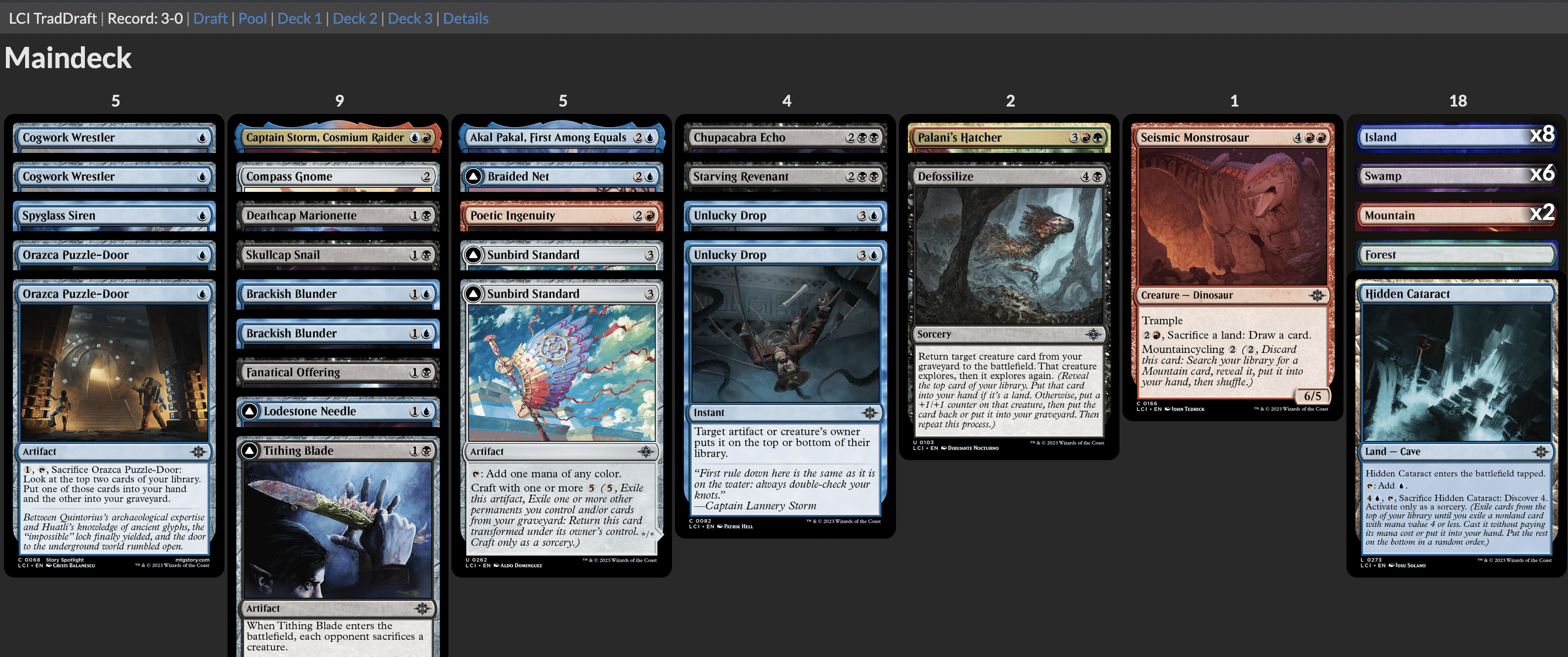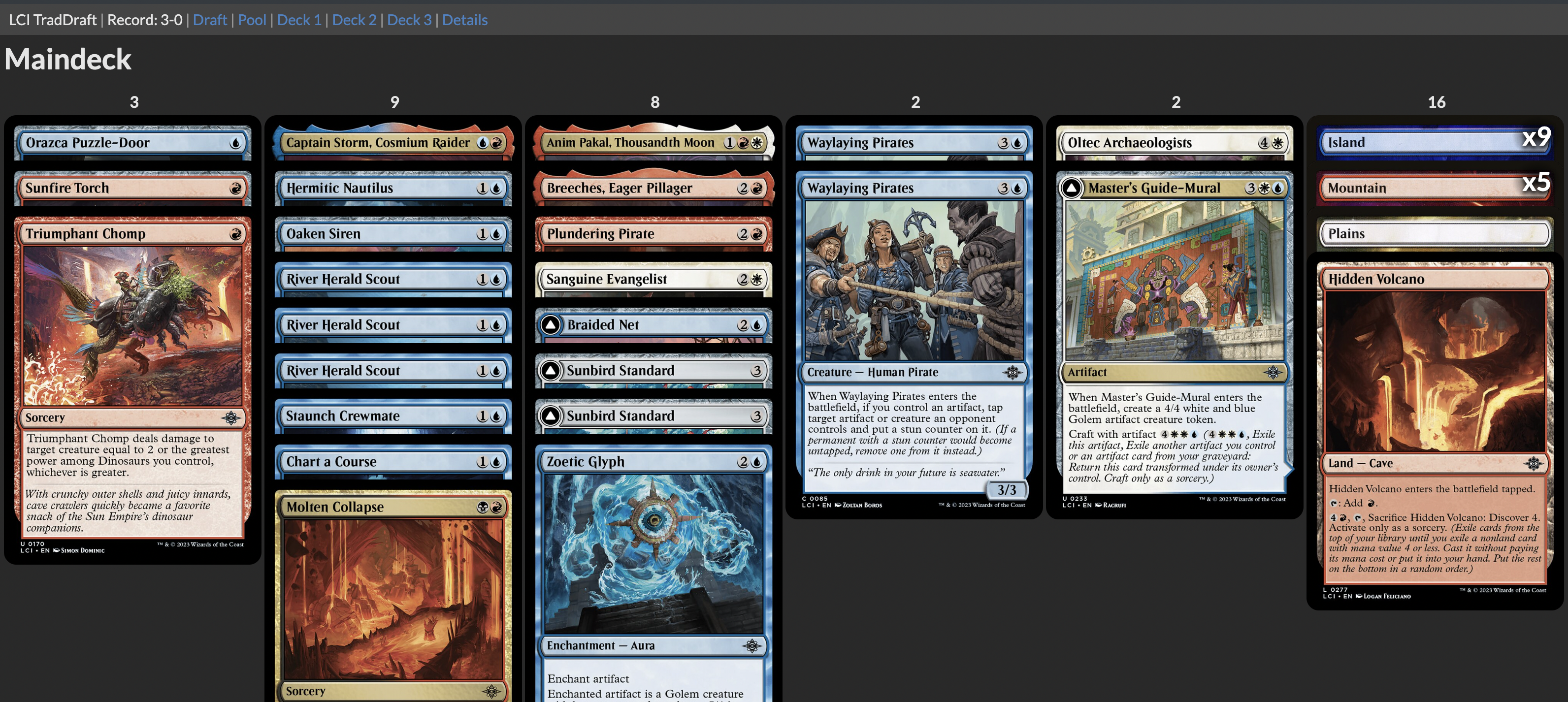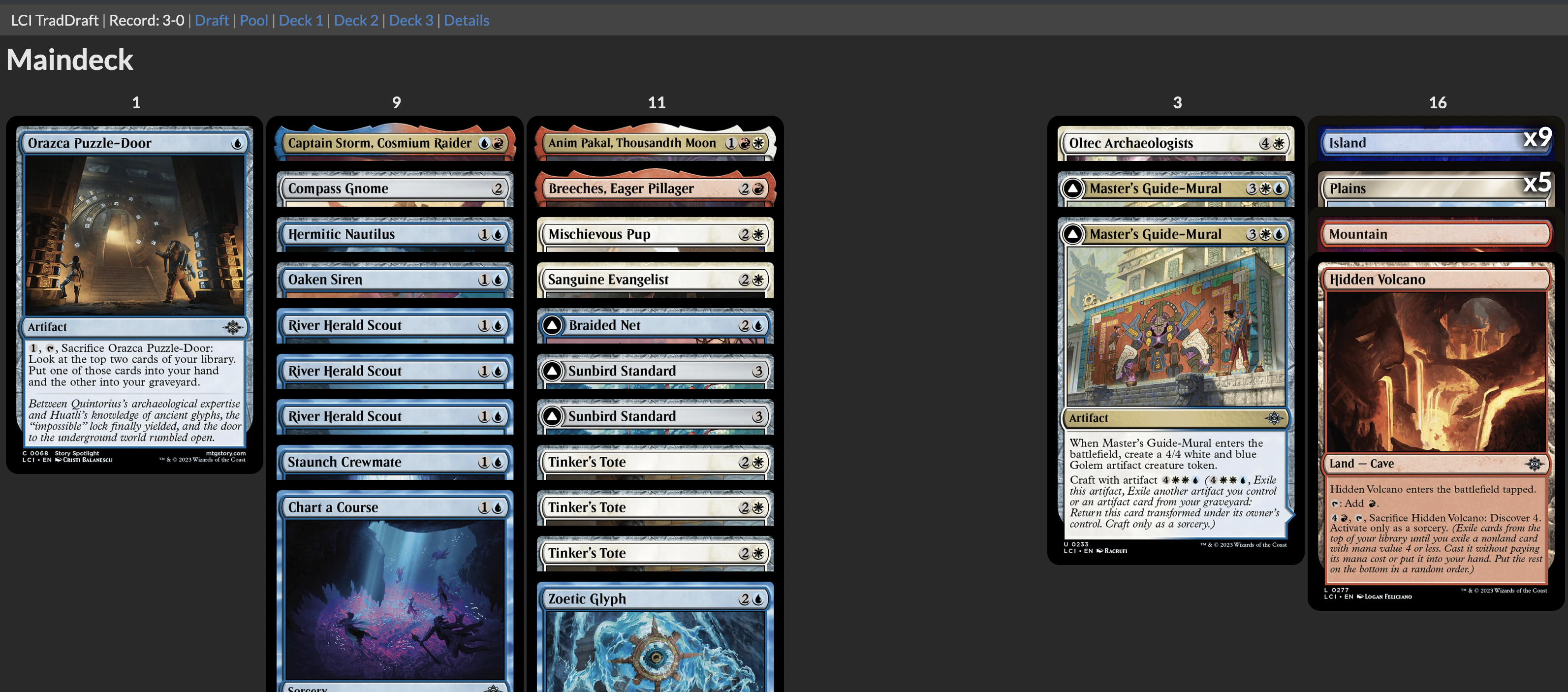Sunbird Standard, and Multicolor Midrange in LCI
11/17/2023
If you know anything about my style of drafting, you probably know that I like splashing. From 5c green midrange decks in KHM, to off-college decks in STX, to 5c adventure decks in WOE, basically every set I try to push the limits of mana fixing.
This set is no different. Across 2 early access drafts, 2 prerelease sealeds, 8 Arena drafts, and one paper draft, I've played 13 copies of
Sunbird Standard. It is almost certainly my most played uncommon, and in those decks I'm often splashing, often multiple cards.And I've been doing very well with these decks too! The community consensus currently is that Jeskai aggro is the best thing to be doing, but I have found a more midrangey approach powerful as well. So far, my Sunbird draft decks have gotten one 5-3, one 6-3 (these were early access Bo1), seven 3-0s (one in paper), and one 2-1. So, let's talk about how I've been making these decks work.
Part 1: Why Splash?
The first thing I need to answer is: what's the payoff for doing this? Why am I playing multiple colors, instead of just sticking to two? (other than the fact that splashing is fun and based, of course)
Well, for one thing, the rares in this set are just really good. And while not all of them are splashable, getting a double-pipped bomb rare still somewhat incentivizes splashing - as you will sometimes switch to the color of your bomb, and have splashable good cards from one of your previous colors.
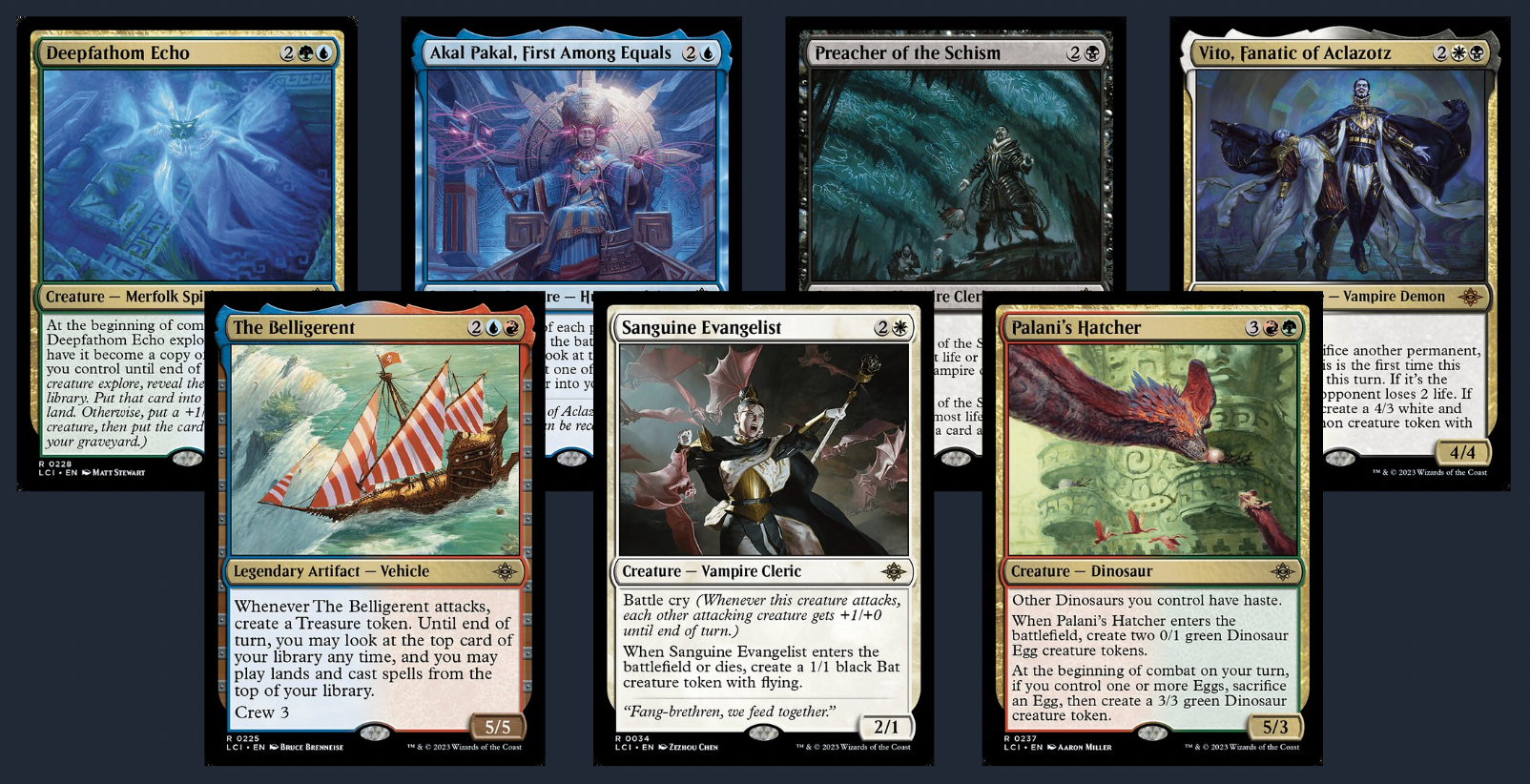
some examples of very splashable very powerful rares
Secondly, while the set as a whole is a bit lacking in good efficient removal, there are quite a few splashable clunky catch-all removal spells. A deck looking to go long might be looking for more hard removal to deal with bombs or big threats, and splashing these cards is not much more painful than casting them normally.
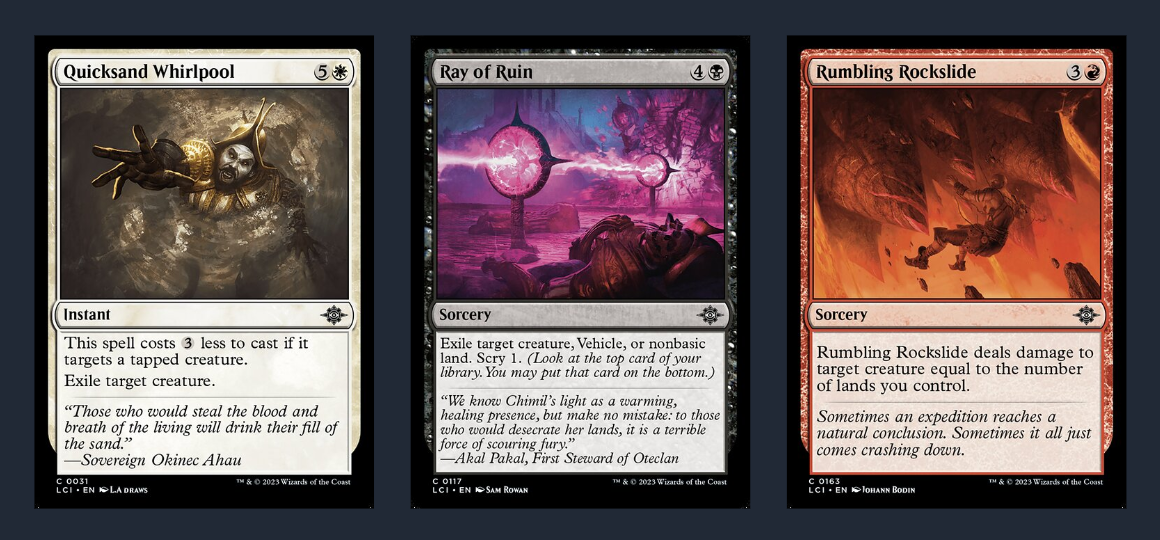
three splashable clunky removal spells at common
Finally, Sunbird Standard ties this all together. Not only does it help you splash, it also actively gets better the more you're splashing!
The backside is only okay when crafted with two colors - a 2/2 flying vigilance that taps for 2 mana is certainly nice, but nothing too special. But once you get to 3 or more colors, it really starts to feel quite ludicrous.
Obviously the increased stats are very nice - 3/3 is a lot better than 2/2. But also, once it starts tapping for more and more mana, the craft also becomes a lot better. Since you can tap the front side before crafting, and the backside enters with haste and so can immediately make mana, with enough colors crafting can be extremely cheap or even free!
At 3 colors, crafting takes net 1 mana (since it costs 5 but you can tap the front for 1 mana and the back for 3 mana); at 4 colors, it's free; and at 5 colors it actually produces more mana. And if you get to untap with your Effigy, suddenly you've ramped multiple times, which can be quite nice for consistently double- and triple-spelling, or for casting spells while also activating caves or expensive craft abilities.
Really, the breakpoint is at 3 colors - a 2 color Sunbird is just a nice thing to do in the lategame, while a 3+ color Sunbird puts you leaps and bounds ahead. More is obviously better, but past 3 it gets pretty hard, both in supporting your splash and just in having cards of so many colors in your graveyard in the first place.
Part 2: Deck Structure
So, what do these decks look like? Well, first I'll drop some examples, along with 17lands links so you can look at the drafts, decks and games in greater detail.
Examples
The Curve
I think one of the biggest misconceptions about splashing is that it must be "slow". When I talk about splashing a lot in a format, I sometimes get comments like "so the format must be slow if you can splash this much, right?" or "but this is a fast format!"
Yes, splashing is generally more suited for decks that want the game to go long, as you take longer to develop your mana and generally only splash more powerful cards that still function when cast later. But this shouldn't be conflated with speed!
In fact, one of the most important parts of these splashy decks is their defensive speed! Some of the cards that play best with Sunbird Standard are 1 mana interactive spells - like
Dead Weight or Cogwork Wrestler - because they let you interact with the board the turn you play Sunbird, so you don't fall behind for taking turn 3 off.Expensive cards can be powerful, yes. But they can also be clunky! And even in a deck playing a 3 mana artifact that ramps, I would much rather use that mana in the form of double spelling every turn with cheap cards, instead of relying on it to cast one big thing per turn. The former is just so much more flexible.
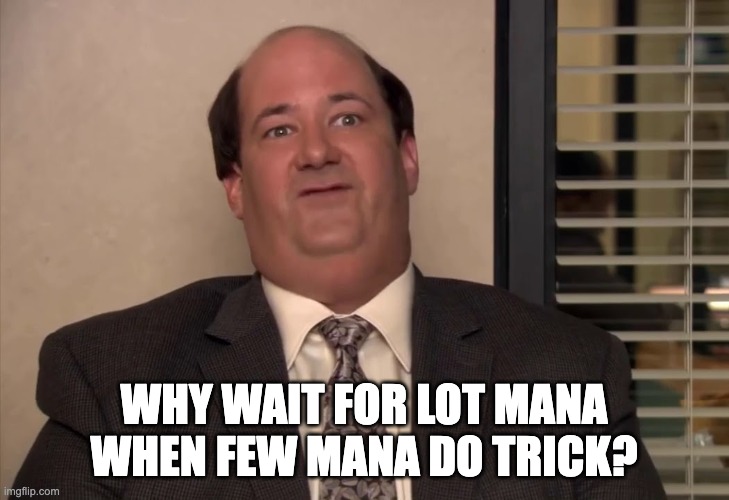
So, as you can see, the curves in these decks are really low. The first example is the most extreme, but all of them focus the curve on 2s and 3s. If you just saw the numbers on the curve without seeing the cards, your first guess might even be that they're aggro decks!
Some notable commons for the purposes of defensive speed:
Cogwork Wrestler: as mentioned above, this card is one of the best ways to stay stable on board after playing Sunbird, and is just a fantastic common in general. It does a lot to fuel so many synergies and let you trade favorable for so little mana.
Cheap removal: Obviously the aforementioned
Dead Weight fits in here, but Brackish Blunder is somehow even better. Various other cheap removal spells are also great, from Abrade to Petrify to Cosmium Blast to Tithing Blade. Don't be afraid to splash more of these if your mana supports it! They can help contribute to your Sunbird crafting.2 drops: you can't just play all interaction! Cheap creatures are great, though the more aggressive ones in red and white aren't at their best. Still, you want some ability to attack and block.
The Midrange Grind
Okay, so we want cheap cards so we can keep up with aggressive starts, that much is clear. But what about games that go long? Won't having a bunch of cheap tempo cards in our deck affect its ability to win long, grindy games?
Well, first of all, it turns out there's quite a lot of cheap cards that scale well into the lategame. Things like
Deathcap Marionette and Poison Dart Frog having deathtouch, or River Herald Scout and Brackish Blunder exploring, or Miner's Guidewing having flying.Secondly, there are quite a few powerful card advantage engines in this set at uncommon and rare, and a lot of them are splashable. Cards like
Lodestone Needle or Twists and Turns can help make sure we never run out of things to do, not to mention all the rares that can draw a card every turn.But most importantly, this set comes with two mechanics that help provide mana sinks quite well: craft, and the common discover caves.
Both of these are mechanics that take a game object that has passed its usefulness (a random artifact for craft; a land for caves), and let you turn them into another card by paying a lot of mana. And it turns out that
Sunbird Standard both helps give us a lot of mana AND crafts into a nice flying threat.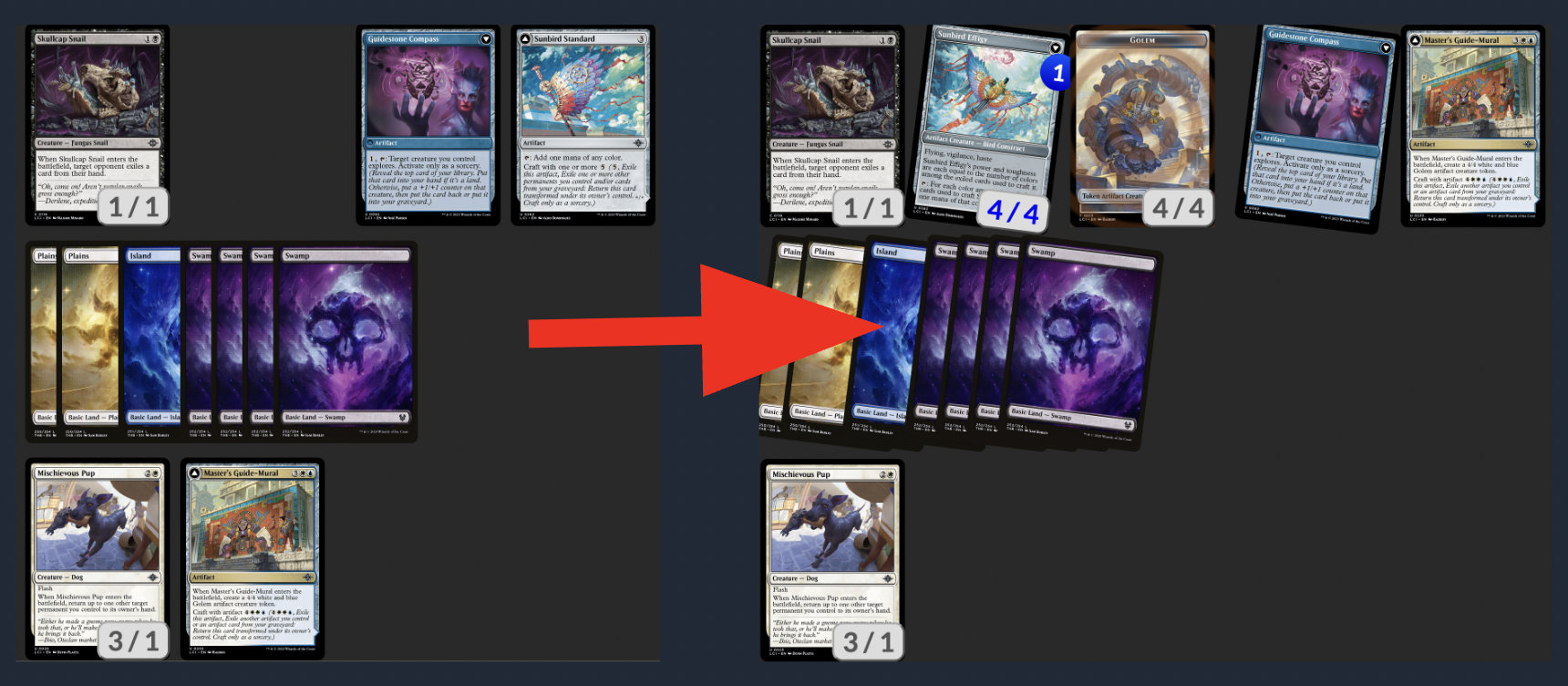
a typical turn of flipping Sunbird - attack for 4 and spend 6 mana doing other things too, setting up for more crafting and double spelling in the future
So many of my games have a similar play pattern: play a bunch of cheap cards early to not die; get down my Sunbird; then flip Sunbird and cast another spell; then after that I just have enough mana that I can start crafting everything and using all my caves, all while attacking for 3 in the air every turn.
Sunbird is really the perfect card for all of this - fixing to let you splash, mana to help you craft, and a threat itself to help you close. Both it and the deck in general both truly embody the definition of midrange - where the goal is to have basically every card be good in basically every situation.
The Removal
On a brief note, as these decks generally do want to go long, you do want to make sure you have removal that can answer your opponent's bombs - I've had versions of this deck that really suffered from just not having any hard removal.
As a baseline, I think I'd want 1-2 hard removal spells in my deck, though it depends on how much more conditional removal you have in addition to that. Thankfully, as I mentioned above, there are quite a few hard removal spells at common that you can splash, and you should be able to get them pretty late too!

these three, again
The Mana
The mana is kind of tricky in these decks sometimes. Sunbird is a great fixer, but sadly you can't guarantee you draw it every game. And you can't support as deep of a splash as you might want with just Sunbird. So let's talk about fixing and mana:
Common colored fixing: Poison Dart Frog and
Plundering Pirate are the only ones I like, but they're both pretty good. However, I don't find myself base green or red much for these decks; the other colors generally have better support, whereas red has more aggressive cards and green is kind of mopey.Landcyclers: these are actually quite good! They don't really count that much for fixing, but allow you to play a lower real land count while having more sources, which is very nice. They also help serve as more cards that are good both while developing and once you have a ton of mana, and have the nice bonus of being fuel to help craft Sunbird for more colors after you cycle them.
Uncommon treasure makers:
Careening Mine Cart and Diamond Pick-Axe are both theoretically good, but they do ask you to be a bit more aggressive, which can work in some decks but might be at odds with others. I haven't had much experience with Enterprising Scallywag but it seems extremely strong in this kind of deck if you can consistently descend.Discover Caves: You generally want something like 2-3 discover caves to help provide ways to spend your Sunbird mana and generally grind in the lategame; you can usually afford the taplands as long as you're properly drafting a low curve.
Cave Fixing:
Scampering Surveyor is quite good, and Compass Gnome is pretty decent too - being able to get a discover cave is actually very relevant for both of them.But also, importantly, the fixing these cards provide is further amplified if you have a copy of
Captivating Cave - being able to fetch a land that fixes for all colors is very powerful. I would prioritize the first copy of Captivating Cave quite highly, to be honest - I've also found the counters pretty relevant, especially with Sunbird being a flyer.Promising Vein is... okay I guess? I'd rather not have to play it, but it does get the job done, if very inefficiently.
16 lands: You might notice that a lot of my example decks have 16 lands! (or 18/44, which is closer to 16/40 than 17/40). I think a lot of these decks will want to run fewer than 17 actual lands, as they often also have Sunbird and landcyclers as additional mana sources.
And as always, I would highly recommend having at least 9 sources of your main color(s) - though in this kind of deck it's also not hard to only have one main color, splashing several others! I find it fairly difficult to actually go to the full 5 colors because of this - I'm generally either solidly splashing a third color or lightly splashing a third and a fourth.
Conclusion and Future Exploration
There's a lot of different ways to build this kind of midrange deck - you could even argue that UW craft is a form version of this, as it plays lots of cheap cards to stabilize early and wins the lategame with craft! But what I really wanted to do today was highlight the powerhouse that is
Sunbird Standard.I wish I could go into more detail, but it's really early in the set, and I still don't think I've fully explored this space. For example, I've been considering the card
Ancestral Reminiscence - maybe this could pull some weight as extra card advantage, if you didn't get as much craft/caves/other card advantage as you wanted?And maybe there's a way to combine this archetype with a deeper caves theme - after all, I do think the common caves are an important part of your lategame. I've had a few
Calamitous Cave-In decks certainly, but haven't really explored the other payoffs; maybe there's something there.Regardless, that will have to wait for later. It's possible I'll revisit this in a future article, but I somewhat doubt it - I think I'm more likely to just add an addendum to this one, maybe before it gets publicly released.
In the meantime, I hope I sold you at least a bit on why and how this strategy can be powerful. Draft cheap cards that stay relevant late with craft and caves, and tie the whole room together with the power of the Sunbird!
Addendum
Update at 11/17 4:30 PM EST: I did another draft and got one of the best versions of this deck I've ever had, so I had to include it here. Two Sunbirds, flush with removal, with a Cave-In, lots of value, and a bit of confirmation that Ancestral Reminiscence does indeed feel good.
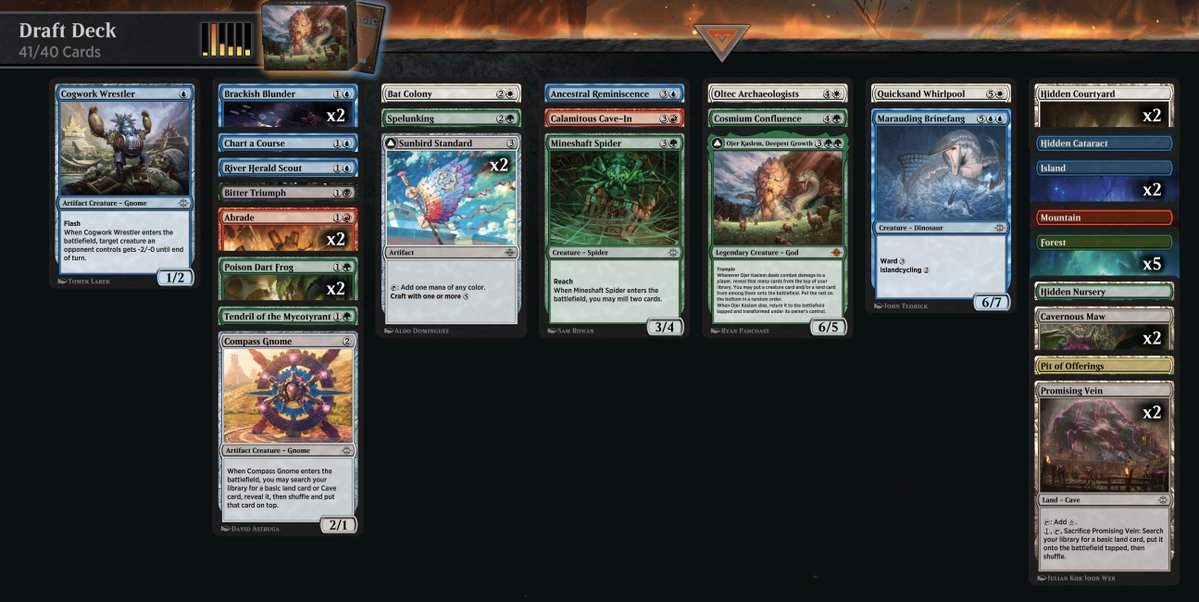
one of the best Sunbird decks I've drafted
Also got my first 5/5 Sunbird with this deck, so I guess the format's solved now.
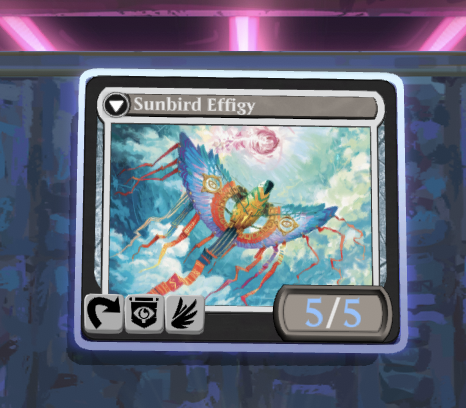
#FreePalestine | Consider donating to UNWRA or PCRF, supporting protesters locally, and educating yourself.



